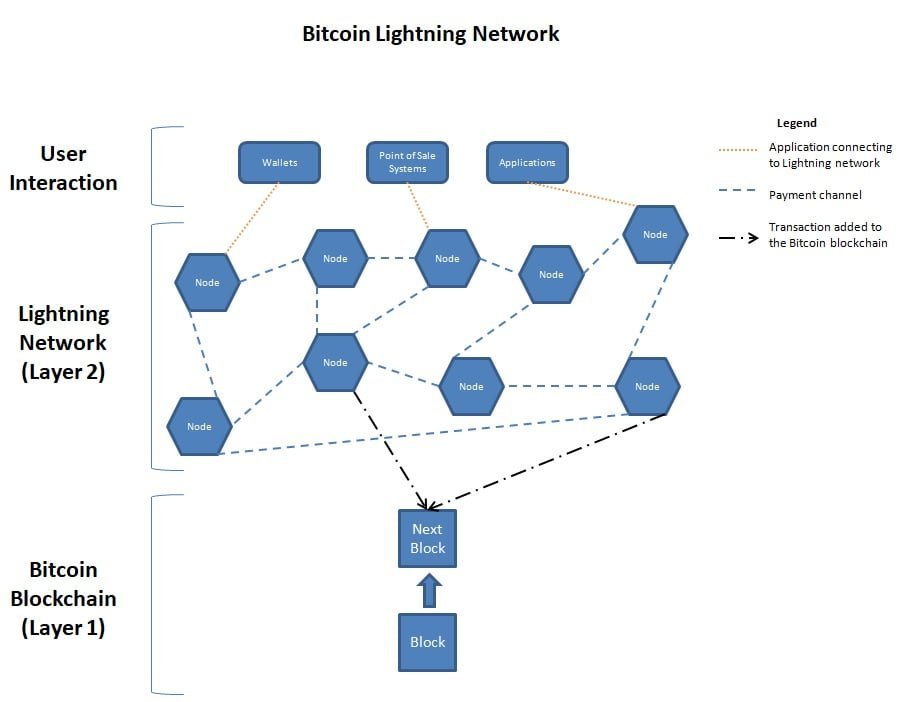Bitcoin’s blockchain and the Lightning Network are both crucial components of the Bitcoin ecosystem, but they serve vastly different purposes. The blockchain is the foundation of the Bitcoin network, while the Lightning Network is a layer built on top of it.
Bitcoin blockchain
To begin with, the blockchain is a decentralized, distributed ledger that records all transactions made on the network. Each block in the blockchain contains a record of multiple transactions, and once a block is added to the blockchain, it cannot be altered. This ensures the integrity and immutability of the transaction data. Furthermore, the blockchain is maintained by a network of nodes, which work together to validate transactions and add them to the blockchain. These nodes are incentivized by the reward they receive for their role in the network, which is called mining.
Lightning network
On the other hand, the Lightning Network is a separate layer built on top of the blockchain. It is designed to enable fast, low-cost transactions between users. The Lightning Network utilizes a technique known as off-chain transactions, which allows users to make payments to each other without having to wait for the transactions to be added to the blockchain. This significantly reduces the time and cost of making a transaction, making it possible to use Bitcoin for small, everyday purchases.

BTC blockchain & Lightning differences
One of the most significant differences between the Bitcoin blockchain and the Lightning Network is their purpose. The blockchain is primarily used for recording and verifying transactions, while the Lightning Network is used for facilitating fast and low-cost transactions. Furthermore, the blockchain is a public ledger that anyone can access, while the Lightning Network is a private network that only users with a direct connection to each other can access.
Another important difference is scalability. Bitcoin’s blockchain can only handle a limited number of transactions per second, which can lead to slow confirmation times and high fees. However, the Lightning Network allows for an almost unlimited number of transactions per second, making it much more scalable. This means that the Lightning Network can handle a much higher volume of transactions, making it more suitable for micropayments, and other use cases that require high scalability.
Advantages of Lightning
In terms of advantages, the Lightning Network offers many benefits over the blockchain. For one, the Lightning Network offers much faster transaction times, which is essential for small, everyday purchases. Additionally, the Lightning Network can greatly reduce the cost of transactions, making it more accessible to users. Furthermore, the Lightning Network is more private than the blockchain, as it doesn’t require transactions to be recorded on a public ledger.
Moreover, the Lightning Network also allows for more advanced functionalities such as atomic swaps, which enables users to exchange different cryptocurrencies without the need of a centralized exchange. Additionally, the use of smart contract technology on the Lightning Network has enabled the creation of decentralized exchanges, which can greatly increase the security of funds, as well as reduce the need for trust in centralized entities.
Bitcoin security
The Bitcoin blockchain achieves security through the use of complex mathematical algorithms and a decentralized network of users. The blockchain uses a consensus mechanism called “Proof-of-Work” which requires users to solve complex mathematical problems in order to validate transactions. Additionally, the decentralized nature of the network ensures that there is no central point of failure and makes it difficult for any one user to gain control of the network. Furthermore, every transaction is recorded on a public ledger, making it transparent and easy to track. Therefore, the Bitcoin blockchain is able to ensure the integrity and security of transactions by utilizing a decentralized network, complex algorithms and a public ledger.
Lightning network security
Security is a top priority for the Lightning Network, a second-layer solution for the Bitcoin blockchain. The network uses “watchtowers” to ensure any attempt to cheat the system is detected, and funds returned to their rightful owner. Additionally, “spontaneous channel closure” prevents fraud by allowing users to quickly close a payment channel if they suspect the other party is attempting to cheat. Furthermore, “multi-path payments” protect against routing attacks by splitting payment into multiple smaller payments. Finally, incentivized “lightning nodes” run by users and organizations all over the world, play a crucial role in the security of the network.
Conclusion
In conclusion, while the blockchain and the Lightning Network are both important components of the Bitcoin ecosystem, they serve very different purposes. The blockchain is primarily used for recording and verifying transactions, while the Lightning Network is used for facilitating fast and low-cost transactions. The blockchain is a public ledger, while the Lightning Network is a private network. Furthermore, The Lightning Network offers faster transaction times, low-cost transaction, advanced functionalities, and greater privacy. As the use of blockchain technology and cryptocurrency continue to evolve, it’s likely that the Lightning Network will play an increasingly important role in the future of Bitcoin and other cryptocurrencies.
